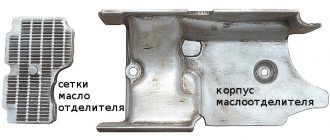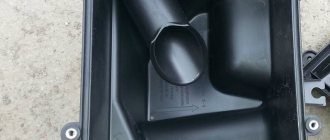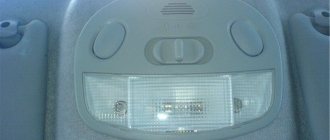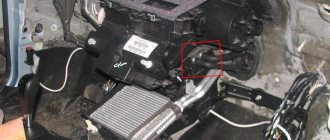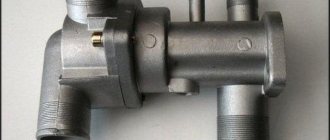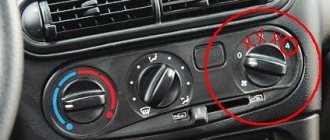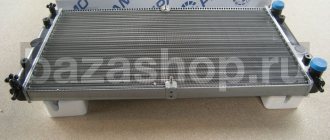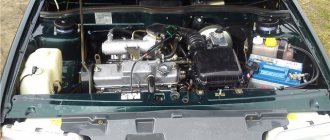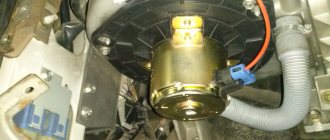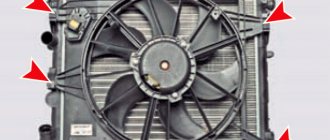The radiator is leaking: what to do, how to find the leak and how to fix it
The cooling radiator is the main element of the engine cooling system.
The operation of a cooling radiator is the active transfer of heat into the atmosphere from the heated coolant. This process is important for efficient engine operation, because The coolant, before giving off heat in the radiator, takes this heat from the heated components and parts of the engine. This was originally intended by the designers, but life makes its own adjustments to the operation of the car on the road. A situation when the arrow on the dashboard begins to treacherously creep up, and, unfortunately, this arrow is not an indicator of the fuel level, but an indicator of the coolant temperature, modestly indicating that the car is starting to overheat. Steam is pouring out from under the hood, and a liquid stain of coolant is slowly but surely spreading on the asphalt. The radiator is leaking, what should I do?
Causes of radiator leaks in the car cooling system
Before you do anything, you need to figure out what led to this result. This may be external damage as a result of stones, or the plastic elements of the radiator may crack as a result of an impact in a minor accident. Such minor damage, as a rule, cannot be immediately identified, and problems arise from them over time. In the meantime, the driver continues to operate the car, gradually, drop by drop, losing coolant from the system.
What is the danger of antifreeze leaking from a car cooling system?
As the coolant level drops, the risk of engine overheating increases, which in turn can lead to the following problems:
Deformation of the plane of the cylinder block or cylinder head
Cylinder head gasket deformation
· Changes in the configuration of the cooling system and associated failure of system components
All of the above cases will lead to expensive repairs.
What to do if the cooling radiator is leaking
The first rule in this case is to monitor the coolant level. In fact, periodically checking the vehicle's technical fluids before a trip is a good rule; this will help to promptly notice an emerging problem and eliminate it.
Even if the cooling radiator leak is small, do not underestimate the scale of the current situation. Over time, radiator leakage will increase, and this point can be overlooked. The driver will not like the result.
Therefore, if such a situation occurs, it is necessary to have a supply of coolant or distilled water. Yes, if the loss of coolant is small, then for the first time you can use distilled water, but you need to take into account that the more distilled water gets into the system, the more we increase the freezing point of the coolant. Therefore, if it’s winter outside, you shouldn’t get carried away with distilled water, but add coolant.
What to do in case of major damage and leakage of the cooling system
If there is serious damage to the engine cooling system, repairs are inevitable; operating the vehicle in this case is extremely undesirable. And in order not to end up with engine repairs, you should move the car to a technical center using a tow truck, or, in extreme cases, on a cable.
How to seal plastic parts of a cooling system with a leak
If the design of the radiator allows, then you can use a heat-resistant sealant-adhesive, better known as cold welding. In some cases, you will need to remove the radiator from the car.
Cold welding is a special two-component sealant that may contain metal shavings. Such sealants allow you to quickly restore plastic or metal parts.
The gluing process itself is not complicated:
· Before applying the sealant, the surface must be prepared, cleaned and degreased.
· Prepare the sealant for use by mixing the two components. The components must be thoroughly mixed to obtain a homogeneous mass.
· The sealant is applied to the part.
The composition will set in 3-5 minutes, but until complete hardening it will take from an hour to a day, depending on the composition.
Is it possible to solder aluminum radiators and how to do it correctly
If a radiator leak occurs on an aluminum part, then sealing is possible. The process is complicated, and we would recommend entrusting it to professionals, because... If the attempt fails, you will have to redo everything again.
· You will need a powerful soldering iron and it must be warmed up well before work.
· The walls of the radiator will also need to be thoroughly heated.
· Clean the surface thoroughly before soldering.
· To ensure good soldering quality, it is necessary to use solder with a high tin content.
This method will require removing the radiator from the car, which means that when installing the radiator back after repair, it is advisable to completely replace the coolant.
Repairing antifreeze leaks in the cooling system using a special sealant
There is another way to eliminate a radiator leak that does not require partial or complete disassembly of the system. This is a sealant that works inside the cooling system. For example, Liqui Moly - Kuhler-Dichter cooling system sealant. This product seals small leaks in the radiator, metal porosity in solder areas, and hairline cracks. Seals damage that is quite difficult to localize (determined only by a drop in the coolant level). You can use the product with all types of additives in the cooling system and any antifreeze. Suitable for all cooling and heating systems.
Contains water-soluble monomer and plastic chips suspended in a monoethylene glycol solution. When there is a pressure difference and when oxygen is available, the polymerization reaction is activated and the polymerization products seal the coolant leaks.
Application of the sealant is very simple:
· Shake the can before use.
· Add sealant to the cooling system at the rate of 250 ml. additives for 10 l. coolant.
· Let the engine idle or drive the vehicle for at least 10 minutes.
The sealant can remain in the cooling system for the entire service life of the coolant.
To avoid major repairs, you should regularly check the cooling system for the slightest malfunctions and leaks, change hoses and pipes in a timely manner, and monitor the temperature of the antifreeze during operation. Also, do not forget to change the coolant in a timely manner, as over time it loses its properties, which can lead to malfunctions in the operation of the entire system.
Source: liquimoly.ru
Major radiator damage
If the crack or damage in the radiator is large, then solving this problem is not easy. It is especially difficult to seal a leak if it is caused by internal corrosion. One of the main repair methods in similar cases is soldering, which requires removing the radiator. At the same time, you need to know that soldering must be done with experience, and in the absence of such knowledge, it is better not to start such work with your own hands, since you can completely render the radiator unusable, which will require its replacement.
The procedure for removing the cooling radiator is the same for many car brands:
- All liquid must be drained from the cooling system. If the engine is hot, you need to wait for it to cool for at least an hour. There are two ways to drain antifreeze: through the drain holes provided by the manufacturer, or through the lower pipe if there are no drain holes.
- After draining the liquid, you need to remove the hoses and pipes.
- Next you need to disconnect the wiring from the fan and sensor.
- Depending on the specific brand of car, the radiator can be pulled out with or without the fan, having first removed it.
After completing all the processes, you need to clean the external radiator from dirt. A clean heat exchanger will make the entire cooling system function more efficiently, which will give positive results in the functioning of the engine.
Means for “treatment”
An excellent way to eliminate leaks in the cooling system are special sealants. The entire process of using such a product comes down to pouring it into the expansion tank of the VAZ cooling system or directly into the radiator. The main advantages of such funds are their following features:
- The sealant is not afraid of exposure to high temperatures.
- The sealant does not evaporate.
- The sealant continues to act for a long time after it has been added to the system, protecting it even after the first use without adding a product to the system.
- The substances in question do not cause damage to the materials that make up the cooling system, such as cast iron, non-ferrous metal alloys, and plastic.
- Does not clog hoses and holes, becoming solid only in leakage areas.
- Does not interact with any of the known coolants.
Reviews
| Prevention, replacement with new ones | ||
| Whistle from under the expansion tank cap | Inspection | Replacement |
| The motor takes a long time to reach operating temperature | Inspecting the antifreeze level | Adding fluid, replacing the thermostat with a new one |
| The temperature sensor systematically shows false data | Inspecting the electrical circuit, measuring the sensor resistance | Replacement with new one |
| No circulation in the main line | Inspection through the expansion tank with the engine running | Washing, removing air pockets |
| № | Positive |
| 1. | Vasily: I’ve been driving a car for a year and a half, no comments. I carry out technical inspections in a timely manner, fill up with high-quality fuel and oils, and have a moderate driving style. |
| 2. | Gennady: at 50,000 km the standard thermostat jammed, replaced it with a new one under warranty. There were no more breakdowns, the machine works like a watch. |
| 3. | Kirill: the rubber pipe burst once where it was fixed with a clamp, I think it was my mistake, I overtightened it. I'm happy with the build quality, no complaints. |
| 4. | Vladlen: I’ve heard negative reviews about Granta, saying that the system is often overstuffed. This happens, but extremely rarely, the defect is not widespread. |
| 5. | Ignat: in order for the machine to work properly and the parts to last longer, it is necessary to treat it with care, care for it, and maintain it. |
| 6. | Dmitry: Six months have passed since the purchase of the car, so far the work is perfect, no investments except for the purchase of consumables. |
| 7. | Valentin: I am satisfied with the build quality of domestic transport; breakdowns do occur, but they are insignificant and can be easily repaired. The engineers managed to combine good quality at an affordable price. |
| Negative | |
| 1. | Ivan: negative experience during operation of the car, already at 45,000 the thermostat jammed, then the bearing flew off. The model is still crude, there are many shortcomings, the manufacturer does not strive to quickly eliminate them. |
| 2. | Vladimir: the build quality is low, after two months of using the car, the rubber pipe cracked and antifreeze began to leak. |
| 3. | Vyacheslav: Lada Granta or Renault Logan - obviously the latter. The manufacturing quality of the French automobile industry is an order of magnitude higher than its domestic counterpart. |
Conclusion As practice shows, most calls to service stations are caused by a jammed thermostat on the Lada Grant. The reasons are different. The factor of manufacturing defects cannot be ruled out, but the fault also lies with the owner of the car.
Buy original spare parts, maintain your car in a timely manner - then the number of breakdowns will be reduced several times.
Source
Advantages of cold welding
To eliminate a leak, it is enough to cut off (break off) a piece of sealant, thoroughly knead it in your hands until it acquires the state and appearance of a homogeneous mass, and then spread it directly onto the damaged area of the VAZ radiator. You can use the car within 15 minutes after drying, and the glue completely hardens a day after the repair.
The main advantages of the glue in question are its following features:
- “Cold welding” has the same coefficient of expansion as metal, which avoids complex repairs after repairing a leak using the substance in question.
- The service life of a patch made from “cold welding”, when applied correctly, can reach several years.
Fluorescent additives will help quickly and effectively identify the location of a leak. They mix with any antifreeze, coloring it. The driver can only inspect the connection points of the pipes (leaks most often occur here) and promptly eliminate the identified malfunction in order to get to the repair site without any problems. When going on a long journey behind the wheel of your own car, it is extremely important to have some kind of sealant with you.
Source: rem-vazik.ru
Sealing plastic parts of a car radiator
Many cars have plastic radiators. They are made from a special composition that is highly durable and resistant to work loads. Repairing such parts has some peculiarities; if they are not taken into account, the adhesive composition will not adhere to the surface. And yet, we have found several ways that will allow you to seal a heating radiator in a car and ensure a high-quality result.
- Soldering is applicable to heat-resistant plastic; you can use a regular soldering iron.
- “Cold welding” is a very successful method for eliminating leaks in a plastic case. If all the work is done correctly, in accordance with the manufacturer’s recommendations, then there will never be a leak in this place. “Cold welding” is tightly bonded to the surface and forms a high-strength connection that is not afraid of vibrations, changes in temperature and pressure.
- Adhesive sealant can only repair small cracks. In the case of large defects, a different method is needed. In any case, this method is a temporary measure.
- 3M DP8005 two-component adhesive adhesive demonstrates high efficiency and is capable of working even with difficult types of plastic. The treated area will not cause a leak, since the seam is not destroyed by external factors and workloads. The only drawback is the high cost, which ranges around 1,500 rubles.
- Hosch welding is specially designed to work with plastic radiators. The result is reliable and durable, the seam is designed for high workloads.
Car radiator leak - elimination + VIDEO
As you know from a physics course, heat is always generated when a motor is running. The car engine performs a huge amount of work and at the same time gets very hot. Even in the very first cars, an engine cooling system was used, without which not a single car would be able to function normally.
There are several types of engine cooling systems:
The vast majority of modern cars use a liquid system, in which cooling is achieved using coolant - antifreeze, antifreeze or plain water. The main element of the cooling system is the radiator, which acts as a heat exchanger.
The radiator has a fairly simple design:
- upper tank - heated liquid enters it;
- core - consists of many thin plates and vertical tubes;
- lower tank - already cooled liquid flows into it.
Cooling occurs due to the fact that the liquid flows into tubes, of which there are a lot. And it is much easier to cool small volumes of a substance than large volumes. An important role in cooling is played by the fan impeller, which, when rotating, creates air flows for faster cooling.
It is clear that if the cooling system stops functioning normally, the engine will very quickly overheat and fail.
Over time, cracks may form in the radiator tubes. The reasons for their appearance can be very different:
- mechanical damage;
- corrosion processes - incorrectly selected antifreeze or antifreeze;
- cracked seams at the joints of the tubes - seams crack due to old age, as well as due to increased pressure inside the radiator.
It is also important to pay attention to the fact that a small leak of antifreeze can only be detected when the engine is running. Even if the leak is very small - a few drops per minute - you will still notice that the liquid level in the tank is decreasing. We have already written on our car portal Vodi.su that good antifreeze or antifreeze is quite expensive, and there is no desire to constantly add it to the radiator. Therefore, measures have to be taken to eliminate the increased consumption of antifreeze.
Operating principle and replacement algorithm
Replacing the heater tap on a VAZ 2114 can take place both in a “garage” environment and at a certified car service center. Considering that a trip to the service station will cost us a tidy sum, we will carry out the repairs ourselves. To do this we need to prepare:
1) A container for draining antifreeze with a volume of at least 7 - 8 liters;
2) New stove heater valve;
3) A canister with new antifreeze or antifreeze;
4) Car portable tool kit;
6) Shoes made of wood or metal;
Methods for eliminating leaks
If you find that the antifreeze level is dropping, you need to take measures as quickly as possible to get to the nearest workshop.
First of all, you need to determine the cause of the leak - the radiator itself is leaking or liquid is leaking from the pipes. If the leak is small, it is not so easy to detect it on the road. Without turning off the engine, try to visually determine the place where the liquid is dripping. If it is winter outside, steam will be released from the hole or crack.
If you are convinced that it is the radiator that is leaking, then you need to determine the extent of the damage. You can prevent a small leak using ordinary eggs, flour, pepper or mustard - under the influence of hot antifreeze, the eggs inside the radiator will boil and the pressure will nail them to the crack. Flour or pepper will also clump into clumps and plug the hole from the inside.
Be very careful before pouring or pouring all this into the radiator - you can only unscrew the cap when the engine is turned off and cooled down , since high pressure is created inside the radiator and a stream of coolant can escape under pressure and burn you. Unscrew the radiator cap, pour one or two eggs inside, or add a small 10-gram bag of pepper, flour or mustard.
According to the testimony of many motorists, this simple method really helps. The leak disappears. However, then you will have to completely remove the radiator and wash it, since the tubes may become clogged and will not allow antifreeze to pass through.
What should I use to temporarily fix a leak?
Liqui Moly products are very popular , namely a product called LIQUI MOLY Kuhler Dichter - this is what experts recommend buying. There are many other similar products, but no one can guarantee that the same flour or mustard is not used in its composition. It’s even worse when dry construction adhesive or cement is added to such sealants. Using such a product will lead to blockage of the honeycombs and subsequent overheating of the engine.
If we talk about Liqui Moly sealants, they contain polymer additives in the form of sparkles, which will not clog the radiator tubes, but will settle precisely at the site of the crack. Although it should be noted that this is only a temporary measure, and the sealant will not clog quite large cracks.
Therefore, you will have to choose from several options:
- solder the radiator;
- glue by cold welding;
- buy a new one.
Danger of constant coolant leakage
The biggest nuisance is engine overheating due to the inability of antifreeze to effectively remove heat. If the cooling radiator leaks, the cylinder head may change its configuration: in this case, the gasket will inevitably fail. In the worst case, the motor will simply jam, which will result in a major overhaul. A lack of coolant in the radiator is also dangerous for the person himself. If the driver opens the hood while antifreeze is boiling, a breakdown of some CO element is possible, resulting in the formation of a real geyser of liquid heated to a high temperature. If it gets on the skin, a burn cannot be avoided.
If your car's radiator coolant leaks, it can cause serious engine damage. Any car engine generates a large amount of heat during operation, and without a cooling system, its operation would become impossible. The heat transfer from the main engine mechanisms is small, so any motor is equipped with a forced cooling system. Even the very first cars had such systems installed. Today, the most used system has become a liquid one, its main element is the radiator.
A special fluid constantly circulates in them, which takes away engine heat and releases it into the external environment. To increase the efficiency of this process, a cooling radiator with a large cooling area is installed. Water, antifreeze or antifreeze is poured into the system circuit, depending on the driver’s decision. You need to know that when using water, you cannot drive a car in winter frosts, as the water will freeze and defrost the radiator.
Posts 8
1 Topic by kos127 2010-01-04 04:23:21
- kos127
- User
- Offline
- Registered: 2009-01-12
- Messages: 6
- Reputation: [ 0 | 0 ]
Topic: Radiator leak
The radiator was leaking somewhere in the area of the tanks. The leak is not large, it drains about 0.5-0.7 liters in two weeks. They advised to fill in special. an additive to eliminate leaks, but with the caveat that it was poured into the six, that is, into the radiator itself. As I understand it, on 9k you will have to fill it into the expansion tank, which I don’t really like. If anyone has tried such additives, please give me some advice: is it worth the trouble or change the radiator and live in peace?
2 Reply from Skipper 2010-01-04 06:38:57
- Skipper
- User
- Offline
- Registered: 2008-11-16
- Messages: 322
- Reputation: [ 0 | 0 ]
Re: Radiator leak
Many people are against stop leaks, but it helped me. On a cold engine it oozed drops, even if you put up a glass. Half a liter of antifreeze per night. I filled it with Stop-Leak from ABRO in a yellow bottle. The leak stopped before our eyes (filled it up and looked at the intensity of the leak). It was completely gone after 3-4 days. I added antifreeze to the level and that was it. Since the summer of that year the flight has been normal.
In your case the leak is minor. You can shed even half the contents of the bottle, or even a third.
3 Reply from Sasha48 2010-01-04 07:51:04
- Sasha48
- User
- Offline
- Registered: 2009-06-26
- Messages: 84
- Reputation: [ 0 | 0 ]
Re: Radiator leak
it makes no difference where to pour it: into the radiator or into the expander or into the stove, or even into the pump - there is still circulation everywhere and everything will mix
4 Reply from TRAKTOR 2010-01-04 12:03:41
- TRAKTOR
- User
- Offline
- Registered: 2010-08-17
- Messages: 15
- Reputation: [ 0 | 0 ]
Re: Radiator leak
My antifreeze goes from the MAX mark to the minimum in a week. The radiator is leaking somewhere in the area of the drain plug, also from the tank.
I’ll probably change the radiator, but I don’t believe that such an additive will help me
5 Reply from Biker22rus 2010-01-04 14:12:31
- Biker22rus
- User
- Offline
- Registered: 2009-04-02
- Messages: 643
- Reputation: [ 0 | 0 ]
Re: Radiator leak
All this is good, of course, small leaks are sealed, but the radiator of the stove is also seriously clogged (((
6 Reply from Count 2010-01-04 16:48:27
- graph
- User
- Offline
- Registered: 2009-12-04
- Messages: 52
- Reputation: [ 0 | 0 ]
Re: Radiator leak
All this is good, of course, small leaks are sealed, but the radiator of the stove is also seriously clogged (((
helping with such a minor leak will probably help, and it started leaking with the arrival of cold weather, so to speak, it’s probably coming to the end of your radiator, so don’t think about it, but in the summer you’ll most likely change it, but as for the stove, not really, if within reasonable limits you don’t add much will suffer
7 Reply from StreetGlow 2010-01-05 13:24:52
- StreetGlow
- User
- Offline
- Registered: 2008-11-10
- Messages: 227
- Reputation: [ 0 | 0 ]
Re: Radiator leak
My radiator and heater tap were leaking. Plus, the thermostat is stuck. I mentioned an additive in the store that seals leaks. I was told that it is better to buy new parts, change them and forget them, but the sealants in the cooling system clog the antifreeze channels and something like scale accumulates on them. I was told the same thing at work in the service department. Maybe if there is a small leak this is advisable. If it flows like a stream, in my opinion it is better to replace it, because you don’t know when it will flow again, but it will flow, as always, at the most inopportune moment.
8 Reply from Skipper 2010-01-05 13:55:07
- Skipper
- User
- Offline
- Registered: 2008-11-16
- Messages: 322
- Reputation: [ 0 | 0 ]
Re: Radiator leak
My radiator and heater tap were leaking. Plus, the thermostat is stuck. I mentioned an additive in the store that seals leaks. I was told that it is better to buy new parts, change them and forget them, but the sealants in the cooling system clog the antifreeze channels and something like scale accumulates on them. I was told the same thing at work in the service department. Maybe if there is a small leak this is advisable. If it flows like a stream, in my opinion it is better to replace it, because you don’t know when it will flow again, but it will flow, as always, at the most inopportune moment.
There are liquid stop leaks, and there are dry stop leaks. It seems clear with liquid ones, but dry ones are in the form of a powder, like poppy seeds, only smaller. This way there will be no scale. If you kill the kid, nothing criminal will happen. If it doesn’t help, he’ll always wash it off. Well, if it comes out like a stream, then of course it’s better to replace it, because to tighten a leaky place, it’s not known how much compound may be needed
How to identify stove malfunctions
First, you need to visually inspect the unit and determine the acceptable level of antifreeze in the expansion tank. Raise the floor mats and see if there are any signs of special fluid leaking. Also, the malfunction may be a consequence of a ruptured pipe, their mechanical damage, or the operation of the radiator.
When the coolant supply regulator can no longer be repaired, an urgent replacement of the VAZ 2114 heater valve is required. To do this, you don’t have to involve professionals, but just repair the system yourself.
First of all, you need to buy a new mechanism; there are three types:
- factory
- ball
- and from ceramic plates
Ceramic heater tap VAZ 2114
All of them have their disadvantages and advantages, and only the owner can decide which crane will be more profitable for his car (in terms of functionality and price equivalent).
Attention: before replacing the stove faucet on a VAZ 2114, you need to make sure that the pipes connecting the heating unit and the radiator are intact and undamaged. Otherwise, over a long period of use, they become less functional and can cause fluid leaks.
What tools are needed for the job?
- Phillips screwdriver.
- Empty container more than 5 liters.
- New faucet.
- Clamp 16-23 mm.
- Antifreeze.
- Regular dry cloths.
- Keys No. 10 and No. 13.
- Silicone sealant.
- If possible, a car inspection pit or a lift.
When everything is in stock, then we can safely change the heater valve of the VAZ 2114.
Detailed product installation instructions
The first thing to do is drain the antifreeze into the prepared container. We place it under the engine and remove the plug on the cylinder block. The valve is located under the center console, and to remove it you need to remove the right side dashboard flap. It is secured with five bolts.
When the liquid is completely glass, do not remove the container far. We find the pipes that lead from the motor to the stove regulator. Loosen the clamps, pull out the tubes, and pour the remaining liquid into the prepared container.
Replacing the heater valve on a VAZ 2114 at the next stage involves lubricating two mounting studs, cleaning them with a brush with steel bristles and “soaking” them with brake fluid.
This must be done, since the nuts can turn when unscrewing, thereby turning a simple job into a huge problem. Why does this happen? The stove faucet is fixed not on studs, but on bolts (the caps are included in the plastic housing).
The nuts securing the unit are self-locking, have a plastic ring, and therefore do not unscrew so easily. What if we add rusted threads and oxidation on the contacts? As a result, stress occurs on the bolt, which can cause damage to the plastic around the head. To fix them, pliers or special keys are used.
Now we need to consider how to remove the heater valve of the VAZ 2114.
What is a heater radiator?
The heater radiator belongs to the cooling system. It looks like a mini version of the main engine cooling radiator and is essentially a small unit that consists of small tubes installed in parallel, connected by a series of cross plates (or fins) designed to dissipate heat. This radiator ensures the operation of the interior heater and the vehicle's glass heating system.
Radiator problems need to be addressed immediately
The most common cooling system problems that car owners have to deal with are two:
- constant leakage of coolant and radiator;
- coking of the radiator, which leads to difficulty in circulating fluid throughout the cooling system.
The most common cause of damage to the integrity of the radiator housing is strong mechanical impact. The relatively thin walls of the radiator can be damaged during repair work or when foreign objects get into it when the car is moving. Quite often, leaks are also observed at the places where the pipes exit the radiator. Whatever the reason for the leak, it must be repaired immediately, since operating a car with a faulty radiator is simply dangerous.
On what principle does a heater radiator work?
Coolant circulates through small tubes in the heater core, entering through one hose and leaving through another. The radiator, by dissipating the heat of the fluid passing through it, provides heating to the cabin, preventing passengers from freezing on a cold winter morning. In addition, the heater radiator is responsible for the operation of the glass heating system. It is connected to the air conditioning system, organized according to almost the same principle.
Cooling system design
The car's cooling system consists of:
- radiator;
- water pump;
- expansion tank;
- pipes and hoses;
- thermostat.
A radiator is a grille of pipes and plates made of light metal: aluminum, brass or copper. Numerous tubes reduce the cooling volume, and plates increase the heat exchanger area.
The heat exchanger for a car cooling system is made of aluminum, copper or brass
All components are connected to each other by pipes and hoses. The water pump (pump) drives coolant through one of the circuits. The thermostat is responsible for circulating the refrigerant in a long or small circle. From a physics textbook we know that a liquid increases in volume when heated. The expansion tank helps compensate for this physical property of antifreeze.
How to understand that the heater radiator is faulty?
Below are five main signs that indicate this particular problem. It is quite simple to understand that the heater radiator has malfunctioned or is out of order. But replacing this radiator is not an easy task.
Important information! Only one or a few signs of a heater core malfunction may appear at a time, but there are situations in which these signs appear all at once. This mainly depends on the age and condition of the car at the time the radiator failed.
Foggy windows
The very first sign of a malfunctioning heater core is sudden fogging of the inner surface of the windows without any obvious reason. Fogging of the windows does not mean slight fogging of the edge of the windshield, but the abundant formation of warm condensation over the entire area of all the windows of the car.
It is possible that while the car was moving, that is, after the engine had warmed up sufficiently, damage to the heater radiator occurred. As a result, heated coolant entered the cabin and caused condensation to form. The thing is that until this moment the liquid circulated in a warm temperature-controlled cooling system, and once in the cabin with a lower air temperature, it began to turn into steam.
Smell of melon
Regardless of whether your car's windows are fogged up due to damage to the heater core, the most unmistakable sign of a leaking heater is the appearance of a sweet, fruity smell in the cabin. This is what coolant smells like, so this smell definitely indicates it is leaking.
If you smell that pleasant smell from the outside of your car, look underneath to see how much coolant has leaked onto the ground.
Excessive coolant consumption by car
If your vehicle (it could be a car, truck, or minivan) suddenly develops a voracious appetite for coolant, and you don't understand why this happened, check to see if the heater core is damaged. If it was not possible to quickly detect the leak, it is likely that the liquid leaked into the cabin from a cold system, so the windows did not fog up, but a puddle formed. The first thing you should check is the floor in front of the front passenger seat. If the floor is wet and these are not wet footprints from shoes or a bag, then the whole issue is a faulty heater core.
Brr! It's cold in the cabin!
Low air temperature in the car interior is not always a sign of a malfunction of the heater radiator. The fan motor or other heater component may have failed (which is a good thing, since replacing some components can be much cheaper than replacing the radiator). But if the lack of heat in the cabin is accompanied by other signs, this indicates a problem with the heater core.
If there is a hole or puncture in the heater core, warm air may escape too quickly before reaching the other end of the heater ducts. Warm, barely warm, or even completely cold air may enter the cabin, depending on the degree of damage.
The engine is hot but the interior is cold
If you notice that the engine has overheated or continues to overheat, you should definitely check the condition of the heater core. But keep in mind that many other factors can cause engine overheating. If the radiator has stopped supplying heat to the vehicle interior, but the engine is still warm, find out if there is a coolant leak at any other point or if other problems have arisen.
Overheating of the engine is extremely dangerous, since it also heats up other critical components of the car, as a result of which they begin to wear out quickly and fail in record time.
If the engine begins to overheat, you should find out the cause as soon as possible and eliminate the malfunction.
If the temperature gauge arrow reaches the red zone, stop using the car and call a tow truck to take the car to a repair shop. Of course, you can ignore these recommendations, but believe me, in this case you will learn a good lesson.
Reasons for replacing the unit
Here are a few reasons why replacement may be required:
- Oxidation. As a result, the effective operation of the part is hampered; although the breakdown is not very terrible, it will be problematic to open and close the tap.
- Liquid leak. This is really a big nuisance, and it’s not even that antifreeze will flood the interior of the car, and it will need to be thoroughly washed, but the danger is that the engine will overheat, because all the coolant will leak out due to a broken faucet.
Heater tap leaking
Heater core replacement procedure
- Disconnect the battery.
- Remove the steering wheel.
- Remove all exterior panels and housings for items such as the fuse box, speakers, and the compartment trim in front of the front passenger seat.
- Remove the glove box, radio, speakers and other accessories.
- Disconnect the instruments (be especially careful where the speedometer cable passes).
- Disconnect and remove the heater and air conditioner control panel.
- Unscrew the bolts and remove the dashboard.
- Do not disconnect the air conditioner (unless absolutely necessary and if you can properly dispose of the freon). Freon should never be allowed to leak, as it negatively affects the ozone layer and is also extremely toxic, especially for people with heart disease.
- Disconnect both hoses from the heater core in the engine compartment.
- Move all air lines and other components away from the heater core housing.
- Remove the radiator housing and place it on the table. Unscrew all bolts and other fasteners to get to the radiator itself.
- Take out the old radiator and replace it with a new one!
When installing the heater core, perform the above procedure in reverse order. If any element breaks during removal, it also needs to be replaced during installation.
Source: okuzove.ru
Radiator related problems
The main problems with the radiator can be divided into two groups:
- Antifreeze leaks;
- The radiator becomes clogged with various debris and does not work one hundred percent.
It is quite simple to understand that there are problems with the cooling system; if the engine begins to overheat and the temperature begins to rise above 95 degrees, then the system cannot cope with the load. It is possible that the pipe has ruptured, or the radiator may have leaked. Often, an aluminum radiator is damaged as a result of accidents, stones, or careless repairs, because its honeycombs are quite soft, and plastic elements can crack upon impact. Any coolant (coolant) leak must be repaired if you want to avoid costly repairs to an overheated engine.
Lada Priora Hatchback ☢SOCHI t-34☜Semidesyatochka › Logbook › Now you can fix the radiator yourself)
If a car's radiator leaks, most of us resort to replacing it.
However, in most cases, the radiator can be repaired rather than replaced. Sometimes no skills are required, but sometimes you cannot do without knowledge in the field of welding or soldering. We learn to determine the condition and try to restore the radiator with our own hands. The most common problem is when the radiator leaks due to age. Coolant runs out from the junction of metal and plastic, which automatically leads to engine overheating. It is not always possible to find a replacement radiator, and repairs will cost at least 2 times less than a new one.
Further discussion will be about car radiators in general, and it doesn’t matter whether it’s repairing a heater radiator, an air conditioner radiator or an engine cooling system radiator. Radiator repair using chemicals. Minor damage can be repaired using special products, which on the market are called radiator restoration fluid, radiator sealant, or powder restorers. The principle of operation is approximately the same: pour radiator reducer into the engine cooling system (ECS). The resulting mixture clogs cracks when exposed to air. Video of radiator restoration fluid in operation:
There is a popular method for repairing radiators. It involves patching holes using cold welding (a material similar to plasticine that hardens after use). It is better to seal a small hole in the radiator after thoroughly degreasing the work surface. If the hole in the radiator is large, then you can use a piece of tin as a patch, which we again glue by cold welding. You can repair radiator honeycombs using a mixture of epoxy resin and hardener. Degrease and pour the substance into the damaged honeycombs and level with a spatula. Now the holes in the radiator are 100% sealed. In general, the folk method involves the use of many materials for sealing, I just showed the main ones. Whether this approach can be called a high-quality radiator repair, decide for yourself.
The following instructions assume knowledge of basic welding and soldering skills. To permanently repair the radiator, you need to remove it, but before that you should drain the coolant from it (described in detail in the article on cleaning the radiator). Now that the radiator has been removed, we can determine its condition and whether the radiator can be repaired or replaced with a new one.
Repair the radiator by soldering. We clean the place that we will restore well and solder a piece of sheet brass (brass radiators). Here you need to resort to a gas torch and a soldering iron.
Radiator repair using argon welding. The filler material here is a special welded aluminum wire. This cannot be done without special equipment. It is worth noting that areas treated with argon will be protected from oxidation. Radiator repair using gas dynamic spraying. When a special powder is accelerated along the inside of the radiator at a very high speed and a coating 1-1.5 mm thick is formed on the damaged surface. There is no point in describing these two methods, because they cannot be done at home.
Video demonstrating radiator repair with argon:
Source
What can happen if there is a lack of coolant?
If the radiator leaks or the pipe ruptures, the following may happen:
- The engine will overheat;
- The cylinder head gasket is deformed;
- When attempting to examine the problem, pressurized liquid may splash into the face, causing burns;
- The engine will seize.
All these troubles can lead to expensive repairs, and damage to health can be irreparable.

